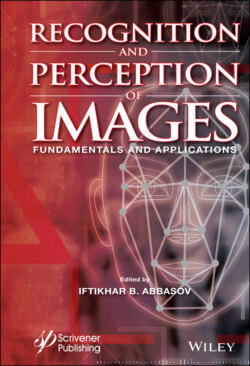Читать книгу Recognition and Perception of Images - Группа авторов - Страница 23
1.2.6 Mach Bands, Hermann’s Grid
ОглавлениеTo demonstrate the effect of lateral inhibition, consider the stepwise stretching of gray color in Figure 1.2.16. The left side of each vertical rectangular strip will appear a little lighter than its right side, which causes an increase in edge contrast. However, each strip has the same lightness; it is filled with a uniform gray color. This can be easily seen if we examine each rectangle alternately, covering the others. The effect of changing the lightness of the marginal sections is named after the 19th-century German physiologist Ernst Mach, who first described this phenomenon [Abbasov, 2016].
Spatial frequencies
Contrast areas of the surrounding field of view can be characterized by spatial frequency, i.e., the number of luminosity variations in a certain part of space. For experimental confirmation, consider Figure 1.2.17. The left upper lattice has a relatively low spatial frequency (wide bands), and the lower one has a higher frequency (narrow bands). The spatial frequencies (bandwidths) of the grids in Figure 1.2.17, on the right are identical and they occupy an intermediate position. Cover the grids in Figure 1.2.17, on the right and for at least 60 s, carefully examine the grids in Figure 1.2.17, on the right, fixing the view on the central horizontal strip between the gratings. After completion of the adaptation period, translate the view into the strip in the center between the two gratings in Figure 1.2.17, on the right. Spatial frequencies will no longer seem identical: the spatial frequency of the upper lattice will seem higher (denser) than the spatial frequency of the lower lattice [Shiffman, 2008], [Gusev, 2007].
Figure 1.2.16 Mach bands.
Figure 1.2.17 Spatial frequency.
Consider the effects based on the phenomenon of lateral inhibition, these include the lattice of Hermann and light contrast. Figure 1.2.18 shows the German grid (German physiologist Ludimar Hermann in 1870), it consists of a white square grid pattern on a black background. The lightness of the white stripes is the same along the entire length; however, phantom gray spots will appear at their intersections. They are due to the suppression of the neural activity of neighboring cells of the retina. If we concentrate our gaze on a separate point of intersection, the gray spot will disappear. In this case, the image is projected on the central fossa, and gray spots appear on other crosshairs, which will be projected on the peripheral areas of the retina with high sensitivity.
Figure 1.2.18 Hermann’s grid.
Figure 1.2.19 “Complementary” grid of Hermann.
You can observe the colored spots on the crosshairs; for this you can choose a grid and a background complementary in color. Such a color grid is shown in Figure 1.2.19, blue spots will appear on the yellow cross hairs [Abbasov, 2019]. When scaling Hermann’s grid, the “phantom” spots will be more stable; for this it is necessary to move the pattern away to the projection of the grid on the retina. From a long distance, the stripes will narrow and phantom spots will be visible regardless of the gaze fixation.
